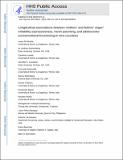| dc.contributor.author | Laura Di Giunta, W Andrew Rothenberg, Carolina Lunetti, Jennifer E Lansford, Concetta Pastorelli, Nancy Eisenberg, Eriona Thartori, Emanuele Basili, Ainzara Favini, Saengduean Yotanyamaneewong, Liane Peña Alampay, Suha M Al-Hassan, Dario Bacchini, Marc H Bornstein, Lei Chang, Kirby Deater-Deckard, Kenneth A Dodge, Paul Oburu, Ann T Skinner, Emma Sorbring, Laurence Steinberg, Sombat Tapanya, Liliana Maria Uribe Tirado | |
| dc.date.accessioned | 2022-01-20T11:37:08Z | |
| dc.date.available | 2022-01-20T11:37:08Z | |
| dc.date.issued | 2020 | |
| dc.identifier.uri | https://repository.maseno.ac.ke/handle/123456789/4418 | |
| dc.description.abstract | The present study examined parents’ self-efficacy about anger regulation and irritability as
predictors of harsh parenting and adolescent children’s irritability (i.e., mediators), which in turn
were examined as predictors of adolescents’ externalizing and internalizing problems. Mothers,
fathers, and adolescents (N = 1,298 families) from 12 cultural groups in nine countries (China,
Colombia, Italy, Jordan, Kenya, Philippines, Sweden, Thailand, and United States) were
interviewed when children were about 13 years old, and again one and two years later. Models
were examined separately for mothers and fathers. Overall, cross-cultural similarities emerged in
the associations of both mothers’ and fathers’ irritability, as well as mothers’ self-efficacy about
anger regulation, with subsequent maternal harsh parenting and adolescent irritability, and in the
associations of the latter variables with adolescents’ internalizing and externalizing problems. The
findings suggest that processes linking mothers’ and fathers’ emotion socialization and
emotionality in diverse cultures to adolescent problem behaviors are somewhat similar. | en_US |
| dc.publisher | American Psychological Association | en_US |
| dc.subject | irritability; anger; harsh parenting; behavior problems; adolescence | en_US |
| dc.title | Longitudinal associations between mothers’ and fathers’ anger/ irritability expressiveness, harsh parenting, and adolescents’ socioemotional functioning in nine countries | en_US |
| dc.type | Article | en_US |

